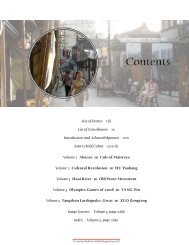Charismatic Megafauna - Berkshire Publishing Group
Charismatic Megafauna - Berkshire Publishing Group
Charismatic Megafauna - Berkshire Publishing Group
You also want an ePaper? Increase the reach of your titles
YUMPU automatically turns print PDFs into web optimized ePapers that Google loves.
64 • THE BERKSHIRE ENCYCLOPEDIA OF SUSTAINABILITY: ECOSYSTEM MANAGEMENT AND SUSTAINABILITY<br />
Big, Popular Mammals<br />
An early reference to charismatic megavertebrates<br />
appears in “Saving ‘<strong>Charismatic</strong>’ Animals,” an article<br />
published in the 22 April 1985 issue of Newsweek magazine.<br />
It both defi nes the concept, with examples, and<br />
presents a case for its use by one of the world’s leading<br />
conservation biologists, Edward O. Wilson. Wilson’s<br />
specialty is the study of ants, and thus his support for the<br />
concept lends extra weight in those zoological circles that<br />
complain that popular vertebrates steal the limelight in<br />
the conservation debate.<br />
Th e latest tactic acknowledges that public support<br />
cannot be mobilized to save the snake mite—or<br />
thousands of other homely beasts. Instead, within<br />
the past year many wildlife conservationists have<br />
forged a policy of preserving and promoting “charismatic<br />
megavertebrates,” the pandas, tigers, okapis<br />
and other glamorous rarities that rivet public sentiment.<br />
If this is a rude repudiation of the conservation<br />
purist’s all-or-nothing creed, it’s also a deftly<br />
plotted political practicality. “Th ere is a sense of<br />
mission now, and of encouragement,” says eminent<br />
Harvard zoologist Edward O. Wilson. “Our most<br />
easily appreciated species can call attention to the<br />
plight of our entire ecosystem.” (“Saving ‘<strong>Charismatic</strong>’<br />
Animals,” 10)<br />
In this application of the strategy, the charismatic<br />
megafauna are employed for the conservation benefi t of<br />
all other species and, in fact, entire ecosystems.<br />
Environmental problems, such as habitat loss and fragmentation,<br />
pollution, introduced species, and climate<br />
change impacts, aff ect all species. <strong>Charismatic</strong> animals<br />
allow us to publicize these generic sustainability issues<br />
and to explore, with popular support, ways of countering<br />
their eff ects, to the benefi t of all wildlife that suff er the<br />
same problems and utilize the same geographical areas.<br />
Furthermore, protecting popular species and their habitats<br />
helps us conserve a habitat network across landscapes,<br />
to the benefi t of all fauna. Th e conservation<br />
zoologist Norman Myers (1996) points out that once<br />
large vertebrate species are lost, the opportunities for new<br />
large vertebrate species to evolve will also be lost in a<br />
planet much modifi ed by human activities.<br />
Th e Newsweek article names three species, describing<br />
them as “glamorous rarities.” Th e panda is arguably the<br />
best-known glamorous rarity, a pin-up charismatic megavertebrate.<br />
In a 1998 editorial in the journal Oryx , Jacqui<br />
Morris observes that mammals make up a relatively small<br />
proportion of the world’s fauna, yet over the previous<br />
decade, half of the papers published in Oryx had mammals<br />
as their primary focus. Morris notes that, in the<br />
www.berkshirepublishing.com<br />
opening paper of that 1998 edition of Oryx , Jeff rey<br />
McNeely makes a plea to fi nd new ways of conserving<br />
mammals beyond research, survey, and anti-poaching,<br />
saying that mammal conservationists need to tackle<br />
underlying issues such as habitat destruction, overexploitation,<br />
and introduced species. Morris thus points to the<br />
tension of highlighting individual species versus addressing<br />
root causes.<br />
Th is theme became the subject of a book by Abigail<br />
Entwistle and Nigel Dunstone, Priorities for the<br />
Conservation of Mammalian Diversity—Has the Panda<br />
Had Its Day? (2000). Th e book notes that, since r ecent<br />
analyses have shown that about a quarter of all mammal<br />
species are threatened with extinction, the conservation<br />
movement is moving rapidly away from a traditional<br />
“protectionist” approach to nature toward a more<br />
integrated view of wildlife and landscape conservation.<br />
Th e British magazine Th e Economist ran an article on<br />
7 January 2008 entitled “Branding Land: Conservation<br />
Marketers Choose Land over Beast,” which makes the<br />
point that although conservation organizations have long<br />
understood the fund- raising value of charismatic megafauna,<br />
the money raised to save these animals often cannot<br />
be spent on broader conservation goals. Th e article<br />
discusses an alternative response adopted by the<br />
Zoological Society of London, which is to focus on<br />
“evolutionarily distinct and globally endangered”<br />
(EDGE) species. Th ese species, the article notes, are<br />
“rarely cuddly” and may “look quite weird,” but they are<br />
often the last representative of an entire animal group.<br />
EDGE species—which include the duck-billed platypus,<br />
the long-beaked echidna, the aardvark, and the dugong—<br />
may not be considered endangered, but it can be argued<br />
that because they are rare from an evolutionary standpoint,<br />
conservation action should be undertaken before<br />
they become endangered.<br />
All Creatures Great and Small<br />
While the public presses for iconic species to be protected,<br />
government resources are often narrowly<br />
focused on threatened species for research and conservation<br />
eff ort, to the neglect of the far greater number of<br />
species that are not listed as threatened. It is important<br />
for managers working to maintain biodiversity to have<br />
statistically workable numbers to determine the impacts<br />
of change, such as from logging, fi re, and climate<br />
change. Th e animals that provide the most eff ective<br />
answers are the common species, and often the least<br />
charismatic, such as native bush rats. Few people are<br />
keen to hear about the ecology of rats, even though<br />
they provide insights for conservation of certain ecosystems,<br />
such as forests or riparian strips (riverbank<br />
Copyright © 2012 <strong>Berkshire</strong> <strong>Publishing</strong> grouP, all rights reserved




